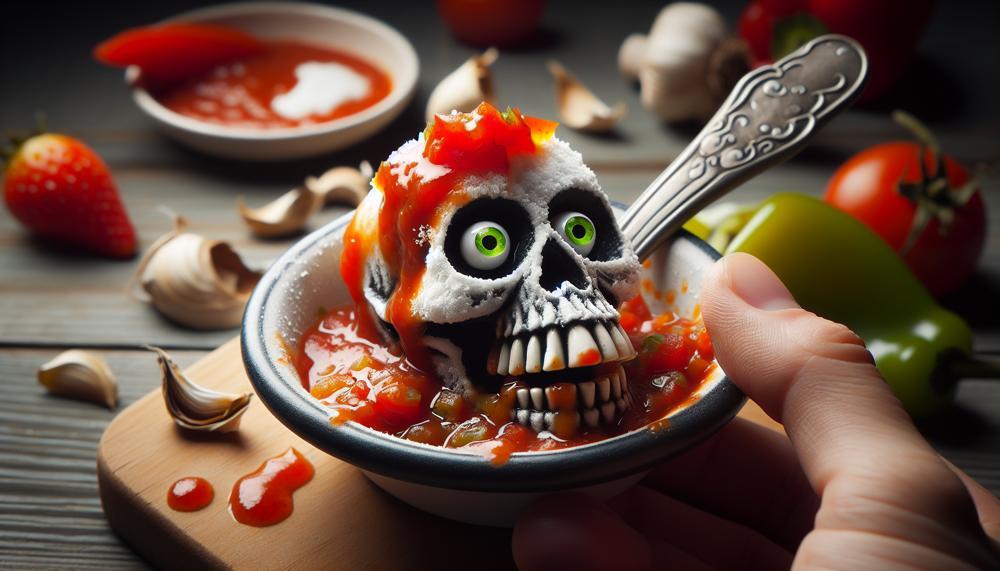Did you know that salsa, the beloved condiment that adds a burst of flavor to your favorite dishes, has a limited shelf life?
Yes, salsa can go bad if not stored and handled properly, posing potential risks to your health. In this article, I will discuss the shelf life of salsa, whether homemade or store-bought, and provide essential tips to ensure your salsa stays fresh and safe to consume.
Contents
Key Takeaways:
- Salsa, both homemade and store-bought, has a limited shelf life.
- Homemade salsa can last for 3-7 days when refrigerated, while store-bought salsa may last up to 2 weeks.
- Proper refrigeration and storage techniques are crucial to maintaining the freshness and safety of salsa.
- Freezing salsa can be an effective method to extend its shelf life.
- Always check for signs of spoilage, such as changes in color or texture, foul odors, or mold, before consuming salsa.
How Long Does Homemade Salsa Last?
When it comes to homemade salsa, the freshness of the ingredients plays a crucial role in determining its shelf life. Without any preservatives, homemade salsa typically lasts for about 3-7 days when stored properly. The key to preserving the flavors and extending the shelf life of homemade salsa is refrigeration.
After making a batch of delicious homemade salsa, it’s important to cover it tightly and refrigerate it as soon as possible. Refrigeration helps slow down the growth of bacteria and keeps the salsa fresh for a longer duration. To ensure maximum freshness and longevity, transfer the salsa to an airtight glass jar or a plastic container before refrigerating.
By refrigerating homemade salsa, you not only prolong its shelf life but also preserve the vibrant flavors and textures of the fresh ingredients. The cool temperature of the refrigerator helps maintain the quality of the salsa, ensuring that it remains tasty and safe to consume.
Tips for Storing Homemade Salsa:
- Refrigerate homemade salsa within two hours of preparation.
- Keep it covered tightly to prevent air exposure and maintain freshness.
- Store it in labeled, airtight containers or glass jars to prevent cross-contamination.
- Place the salsa in the coldest part of the refrigerator, usually the bottom shelf.
- If the salsa starts to show signs of spoilage, such as an off smell or unusual color, it’s best to discard it to avoid any health risks.
By following these storage tips, you can maximize the shelf life of your homemade salsa, ensuring that it remains flavorful and safe to enjoy for as long as possible.
| Storage Method | Shelf Life |
|---|---|
| Refrigeration | 3-7 days |
| Freezing | Up to 3 months |
How Long Does Store-Bought Salsa Last?
When it comes to store-bought salsa, the length of its shelf life can vary depending on the specific brand and ingredients. However, thanks to preserving agents, store-bought salsa typically has a longer shelf life compared to homemade salsa.
After opening, store-bought salsa can last up to 2 weeks in the fridge if it is stored properly. This means transferring the salsa to an airtight container and ensuring it is kept refrigerated at all times. By doing so, you can help preserve the freshness and quality of the salsa for a longer period.
To ensure you consume the salsa before it spoils, it’s always recommended to check the expiration date on the jar. This provides you with a clear indication of the salsa’s shelf life and helps you avoid consuming expired products.
Salsa that has exceeded its shelf life or shows signs of spoilage should be discarded to prevent any risk of foodborne illness. It’s important to trust your senses and look out for any changes in color, texture, or odor. If the salsa has developed an off-putting taste or if you notice any mold growth, it’s best to err on the side of caution and dispose of it properly.
So, store-bought salsa can last up to 2 weeks in the fridge if stored correctly. Preserving agents play a crucial role in prolonging its shelf life. Remember to always check the expiration date, trust your senses, and prioritize food safety when enjoying store-bought salsa.
| Store-Bought Salsa | Shelf Life |
|---|---|
| Brand A | Up to 2 weeks |
| Brand B | Up to 2 weeks |
| Brand C | Up to 2 weeks |

Can Salsa be Left Out?
Once salsa has been opened, it is crucial to refrigerate it promptly to ensure food safety and maintain its freshness. Leaving salsa out at room temperature for an extended period can lead to the growth of harmful bacteria, increasing the risk of foodborne illnesses.
To prevent this, it is essential to store salsa in a refrigerated environment as soon as possible after opening. Refrigeration helps inhibit bacterial growth and preserves the quality of salsa, allowing you to enjoy it for a longer time.
Why is refrigeration important for salsa?
Refrigeration plays a significant role in preserving the freshness and taste of salsa. It helps slow down the enzymatic reactions that cause food spoilage and prevents the growth of bacteria, yeasts, and molds. By keeping salsa at a cold temperature, you create an unfavorable environment for the proliferation of microorganisms.
Additionally, refrigeration helps maintain the texture and color of salsa, ensuring it stays vibrant and appetizing. Salsa that is left out for too long can become discolored, watery, and develop an off-putting texture.
Storing salsa for optimal freshness and safety
To ensure maximum shelf life and quality of salsa, remember these key storage tips:
- Refrigerate it promptly: Once the jar of salsa is opened, immediately transfer it to the refrigerator, keeping it at a temperature below 40°F (4°C).
- Use airtight containers: Store salsa in airtight glass jars or plastic containers to prevent exposure to air, which can hasten spoilage. Ensure that the lids are tightly sealed after each use.
- Avoid cross-contamination: Always use clean utensils when scooping salsa to prevent introducing any contaminants that could accelerate its deterioration.
Salsa Refrigeration Guidelines
| Salsa Type | Storage Location | Shelf Life (After Opening) |
|---|---|---|
| Homemade Salsa | Refrigerator | 3-7 days |
| Store-Bought Salsa | Refrigerator | Up to 2 weeks |
How Should You Store Salsa?
Proper storage of salsa is crucial to preserve its freshness and prevent spoilage. Whether you have an unopened jar or have already cracked it open, following these guidelines will help you maintain the quality of your salsa.
Unopened Salsa
If you have shelf-stable salsa in your pantry or cabinet, there’s no immediate need for refrigeration. The unopened jars can be stored at room temperature until the expiration date.
Refrigerated Salsa
If you have refrigerated salsa, it’s important to keep it chilled. Once you’ve opened the jar, transfer the salsa into an airtight glass jar or a plastic container suitable for refrigeration. This will help maintain its freshness and extend its shelf life.
Tip: Choose a storage container that is appropriately sized to minimize air exposure. Excess air can cause the salsa to spoil more quickly.
| Storage | Salsa Type | Duration | Location |
|---|---|---|---|
| Unopened | Shelf-stable | Until expiration date | Pantry or cabinet |
| Opened | Refrigerated | 3-7 days | Refrigerator |
Remember to close the lid tightly after each use to prevent air from entering the container, which can lead to the growth of bacteria and deterioration of the salsa’s flavor. Storing your salsa properly will help you enjoy its delicious taste for longer.
Can You Freeze Salsa?
Yes, salsa can be frozen to extend its shelf life. Freezing salsa is a great option when you have leftover salsa or want to save salsa nearing its expiration date. By freezing salsa, you can preserve its quality and flavor for future use.
To freeze salsa, follow these simple steps:
- Transfer the salsa to a smaller container or freezer bag.
- Remove any excess air from the container or bag before sealing it tightly. Excess air can cause freezer burn and affect the taste and texture of the salsa.
- Label the container or bag with the date of freezing to keep track of its freshness.
- Place the salsa in the freezer, ensuring it’s stored in a proper location where it won’t get crushed or damaged.
When you’re ready to use the frozen salsa, simply thaw it in the refrigerator overnight. Avoid thawing salsa at room temperature to prevent bacterial growth. Once thawed, give the salsa a good stir before consuming to redistribute any separated liquids and ensure an even consistency.
Remember: Freezing salsa can extend its shelf life, but it may slightly change the texture compared to fresh salsa. However, the flavor should remain intact, making it a convenient option for preserving salsa for longer periods.
How to Tell if Your Salsa Has Gone Bad?
When it comes to enjoying salsa, it’s important to ensure that it’s fresh and safe to eat. There are several signs you can look out for to determine if your salsa has gone bad:
-
Changes in color or texture: If you notice any unusual changes in the color or texture of your salsa, such as discoloration, separation, or a slimy consistency, it may be a sign of spoilage.
-
The presence of mold or a foul odor: If you see any mold growing on the surface of your salsa or detect a foul odor, it’s a clear indication that it has spoiled. Mold growth and unpleasant smells are signs of bacterial or fungal contamination.
-
Dents or swelling on the lid: If you notice any dents or swelling on the lid of your salsa jar, it could be a sign that the product has been compromised and air has entered the container. This can lead to bacterial growth and spoilage.
-
A bad taste: The most obvious sign that salsa has gone bad is when it tastes off or has a sour or unpleasant flavor. Trust your taste buds, as they can often detect spoilage even before other signs become apparent.
If you observe any of these signs in your salsa, it’s crucial to discard it immediately. Consuming spoiled salsa can lead to foodborne illness, which can cause symptoms like nausea, vomiting, diarrhea, and stomach cramps. Protect your health by prioritizing food safety.
Sample Table: Signs of Salsa Spoilage
| Signs of Spoilage | Explanation |
|---|---|
| Changes in color or texture | Discoloration, separation, slimy consistency |
| The presence of mold or foul odor | Mold growth, unpleasant smells indicate bacterial or fungal contamination |
| Dents or swelling on lid | Indicates compromised seal, potential bacterial growth |
| Bad taste | Off, sour, or unpleasant flavor |
Tips for Extending Salsa Shelf Life
To ensure the freshness and quality of salsa for an extended period, it’s crucial to follow these tips for proper storage and handling:
- Refrigerate homemade salsa immediately: After preparing homemade salsa, refrigerate it promptly to slow down bacterial growth and preserve its flavor.
- Use clean utensils: Always use clean utensils to scoop salsa from the jar. This prevents cross-contamination and the introduction of bacteria that can accelerate spoilage.
- Seal the jar tightly: After each use, make sure to tightly seal the jar containing salsa. This helps prevent air from entering the container, which can lead to spoilage and loss of freshness.
- Store unopened salsa in a cool, dry place: If the salsa jar is unopened, keep it in a cool and dry location, such as a pantry or kitchen cabinet. Avoid exposing it to direct sunlight or heat sources that can speed up the deterioration process.
By following these salsa shelf life tips, you can ensure the longevity of your salsa while maintaining optimal food safety and flavor.
Conclusion
In conclusion, understanding the salsa shelf life is crucial for ensuring food safety and preserving freshness. Whether you have homemade salsa or store-bought salsa, proper handling and storage are key to maintaining its quality.
Homemade salsa, made with fresh ingredients, can last for about 3-7 days when refrigerated. It’s important to refrigerate it promptly after preparation to prevent bacterial growth and maintain its flavor.
On the other hand, store-bought salsa, which often contains preserving agents, can last up to 2 weeks in the fridge after opening. However, it’s essential to check the expiration date and follow the storage instructions provided on the jar.
For extended storage, freezing salsa is an option. Transfer it to a smaller container or freezer bag, removing excess air before sealing. Freezing helps to extend the shelf life and preserves the taste of salsa for future use.
Keep in mind that signs of spoilage, such as changes in color, texture, the presence of mold or a foul odor, dents or swelling on the lid, or a bad taste, indicate that the salsa has gone bad. In such cases, it’s best to discard the salsa to avoid any risk of foodborne illness.
To ensure the longest possible salsa shelf life, remember to refrigerate homemade salsa immediately after preparation, use clean utensils, and seal the jar tightly after each use. Store unopened salsa in a cool and dry place.
By following these guidelines, you can enjoy salsa safely and preserve its freshness for as long as possible.
Source Links
- https://pepperpalace.com/blogs/expert-tips/when-salsa-goes-bad-tips-for-keeping-salsa-fresh
- https://www.mikeyvsfoods.com/post/how-long-does-salsa-last




